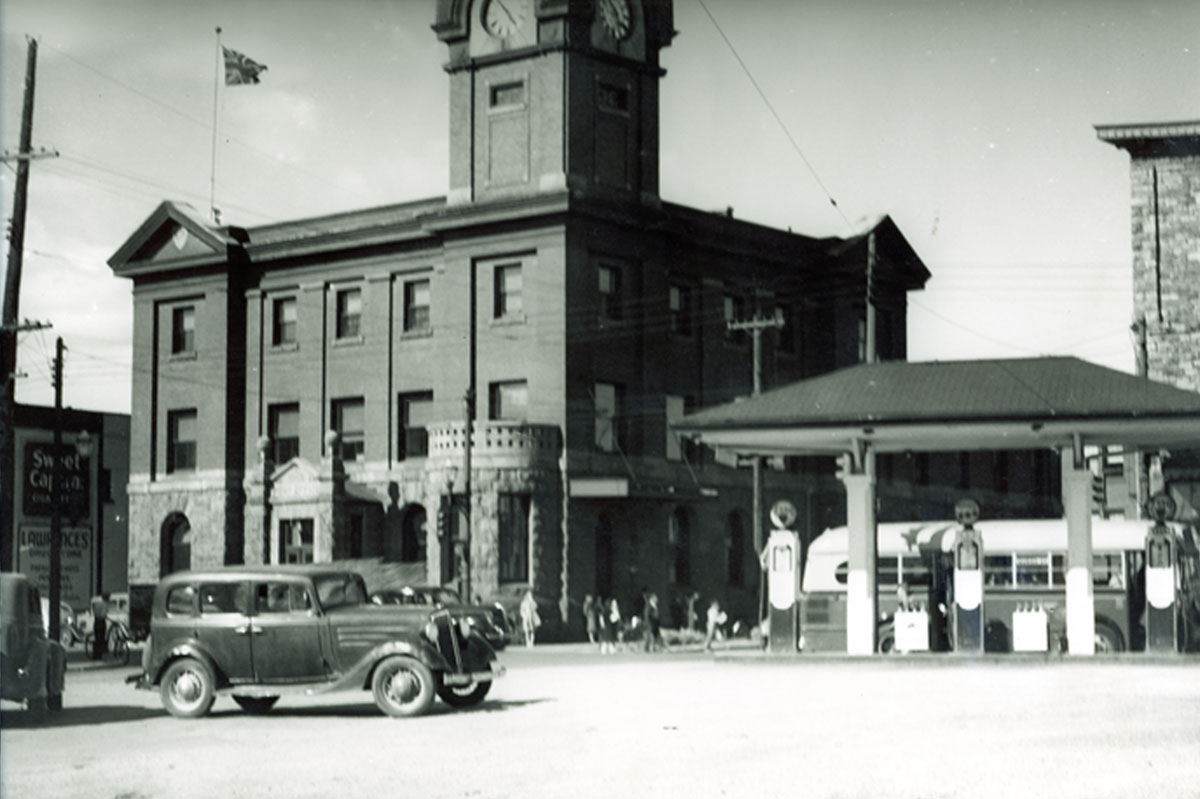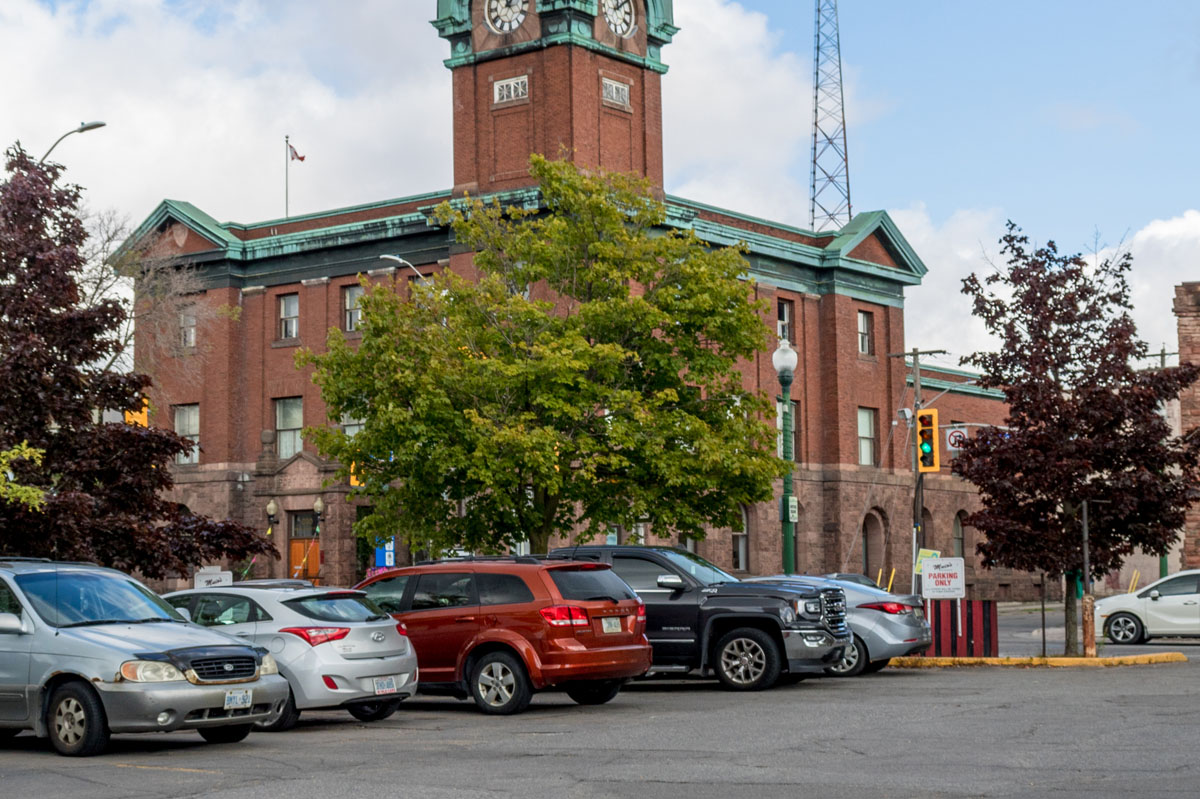Sault Ste. Marie Receiving Station
During the First World War, Canada set up a network of 24 internment camps and receiving stations to process and imprison some 8,579 'enemy aliens' and prisoners of war. In Sault Ste. Marie, the federal building, which is now home to the Sault Ste. Marie Museum, became a receiving station for those immigrants from enemy countries. Between January 1915 and June 1918, some 43 enemy aliens were held here as they awaited transfer to other purpose-built internment stations, like the forced labour camp at Kapuskasing in northern Ontario.1 Some of those arrested locally were held in a small internment camp on nearby Whitefish Island, just opposite the locks of the Soo Canal.
By 1916 there were apparently 1,700 "enemy aliens" registered in Soo and required to report every week to the registrar. If they failed to report, or were found to be homeless or destitute when they did, they would be fined and, in some cases, interned at the Sault Ste Marie Receiving Station to await transfer to another internment camp.
By 1916 there were apparently 1,700 "enemy aliens" registered in Soo and required to report every week to the registrar. If they failed to report, or were found to be homeless or destitute when they did, they would be fined and, in some cases, interned at the Sault Ste Marie Receiving Station to await transfer to another internment camp.
* * *
Soo's Italians: Racism and Internment
For a city of its size, Sault Ste. Marie had a very large foreign population in 1914. Most were working class men who had come to the area to work in the region's burgeoning industries, especially the Algoma Steel Mill. They were paid abysmally low for the standards of the day: 17.5 cents an hour for a ten hour shift at the mill.3
In the early 1900s, the British-descended elites of Sault Ste. Marie looked upon this foreign population with distaste. A 1912 article in the Sault Daily Star complained about the estimated 4,500 "foreigners" living permanently in Sault, saying "It is a certainty the number is very high—too high for the good of the community."
The writer's complained of the slumlike conditions that persisted in the city's immigrant quarter, and the willingness of these people to work for cheaper wages, such that "Canadian labour could not compete with them."4
Another article claimed: "The general consensus… among the city officials… is that the Italians and Polacks are the worst in regard to sanitary conditions."5
They blamed this on the transient nature of the Italian immigrants, who apparently worked in Sault to earn money, and then returned to Italy. Whether the ruthless exploitation of these immigrants by their factory employers played some role in their poverty was not considered.
The situation of Italians in Sault Ste. Marie is an interesting one, in light of what was to happen when war broke out with Germany and Austria-Hungary.
Prior to the war Italy had been part of the Triple Alliance with those two powers, and it was expected Italy would soon join the Central Powers. Thus when the War Measures Act classified all immigrants from enemy nations as enemy aliens, Italian immigrants were also treated with suspicion—though not technically enemy aliens. The Canadian government began banning all money orders to Italy, which severely impacted the many Italians in Soo who were sending remittances home to their families.6
There were some Italians, too, who came from lands controlled by the Austro-Hungarian Empire. These Italians were considered enemy aliens, and during the war a number of them were arrested and interned.
The Italian government eventually decided to join the war on the Allied side in May 1915, after engaging in a hugely cynical bidding war with both sides of the conflict. Italy's joining the Allied cause helped improve the status of the Italians in the city somewhat.
During the war Canada's newspapers showed a barely concealed hatred for the Germans and Austro-Hungarians (primarily Ukrainians) who lived in Canada, and callously debated their post-war fate—whether or not all several hundred thousand of them should be deported en masse.
In Soo, however, it appears that the most bile was still reserved for Italians—even though Italy was an Allied power, and hundreds of Soo's Italians had fought and died in both the Canadian and Italian armies.
In 1918 one letter to the editor of the Daily Star complained that a recent editorial on "How to Deal with the Foreigner," focused on Italians, and "Nothing was said of the Austrians who live in the same locality and under the same conditions. The Italian was singled out for a lot of the most vituperative and unmerited abuse."7
The more or less open racism towards Italians continued after the war. During the 1920s a chapter of the KKK formed in Sault Ste. Marie and soon boasted 600 members. They focused their ire on Italian Catholics especially, burning crosses on Italians front yards, striking fear into the hearts of the city's Italians. One local, Dorothy Bonnell, remembers attending a family gathering during her childhood, and hurriedly being told by her family to shutter the windows, turn off the lights, and quiet down. A KKK procession had been spotted marching up the street.8 During the Second World War, when Italy did fight against the Allies, Canada sent up another system of internment camps, and many of Soo's Italians were interned. Most were sent to an internment camp at Petawawa, which had already served as an internment camp during the First World War.
For a city of its size, Sault Ste. Marie had a very large foreign population in 1914. Most were working class men who had come to the area to work in the region's burgeoning industries, especially the Algoma Steel Mill. They were paid abysmally low for the standards of the day: 17.5 cents an hour for a ten hour shift at the mill.3
In the early 1900s, the British-descended elites of Sault Ste. Marie looked upon this foreign population with distaste. A 1912 article in the Sault Daily Star complained about the estimated 4,500 "foreigners" living permanently in Sault, saying "It is a certainty the number is very high—too high for the good of the community."
The writer's complained of the slumlike conditions that persisted in the city's immigrant quarter, and the willingness of these people to work for cheaper wages, such that "Canadian labour could not compete with them."4
Another article claimed: "The general consensus… among the city officials… is that the Italians and Polacks are the worst in regard to sanitary conditions."5
They blamed this on the transient nature of the Italian immigrants, who apparently worked in Sault to earn money, and then returned to Italy. Whether the ruthless exploitation of these immigrants by their factory employers played some role in their poverty was not considered.
The situation of Italians in Sault Ste. Marie is an interesting one, in light of what was to happen when war broke out with Germany and Austria-Hungary.
Prior to the war Italy had been part of the Triple Alliance with those two powers, and it was expected Italy would soon join the Central Powers. Thus when the War Measures Act classified all immigrants from enemy nations as enemy aliens, Italian immigrants were also treated with suspicion—though not technically enemy aliens. The Canadian government began banning all money orders to Italy, which severely impacted the many Italians in Soo who were sending remittances home to their families.6
There were some Italians, too, who came from lands controlled by the Austro-Hungarian Empire. These Italians were considered enemy aliens, and during the war a number of them were arrested and interned.
The Italian government eventually decided to join the war on the Allied side in May 1915, after engaging in a hugely cynical bidding war with both sides of the conflict. Italy's joining the Allied cause helped improve the status of the Italians in the city somewhat.
During the war Canada's newspapers showed a barely concealed hatred for the Germans and Austro-Hungarians (primarily Ukrainians) who lived in Canada, and callously debated their post-war fate—whether or not all several hundred thousand of them should be deported en masse.
In Soo, however, it appears that the most bile was still reserved for Italians—even though Italy was an Allied power, and hundreds of Soo's Italians had fought and died in both the Canadian and Italian armies.
In 1918 one letter to the editor of the Daily Star complained that a recent editorial on "How to Deal with the Foreigner," focused on Italians, and "Nothing was said of the Austrians who live in the same locality and under the same conditions. The Italian was singled out for a lot of the most vituperative and unmerited abuse."7
The more or less open racism towards Italians continued after the war. During the 1920s a chapter of the KKK formed in Sault Ste. Marie and soon boasted 600 members. They focused their ire on Italian Catholics especially, burning crosses on Italians front yards, striking fear into the hearts of the city's Italians. One local, Dorothy Bonnell, remembers attending a family gathering during her childhood, and hurriedly being told by her family to shutter the windows, turn off the lights, and quiet down. A KKK procession had been spotted marching up the street.8 During the Second World War, when Italy did fight against the Allies, Canada sent up another system of internment camps, and many of Soo's Italians were interned. Most were sent to an internment camp at Petawawa, which had already served as an internment camp during the First World War.


